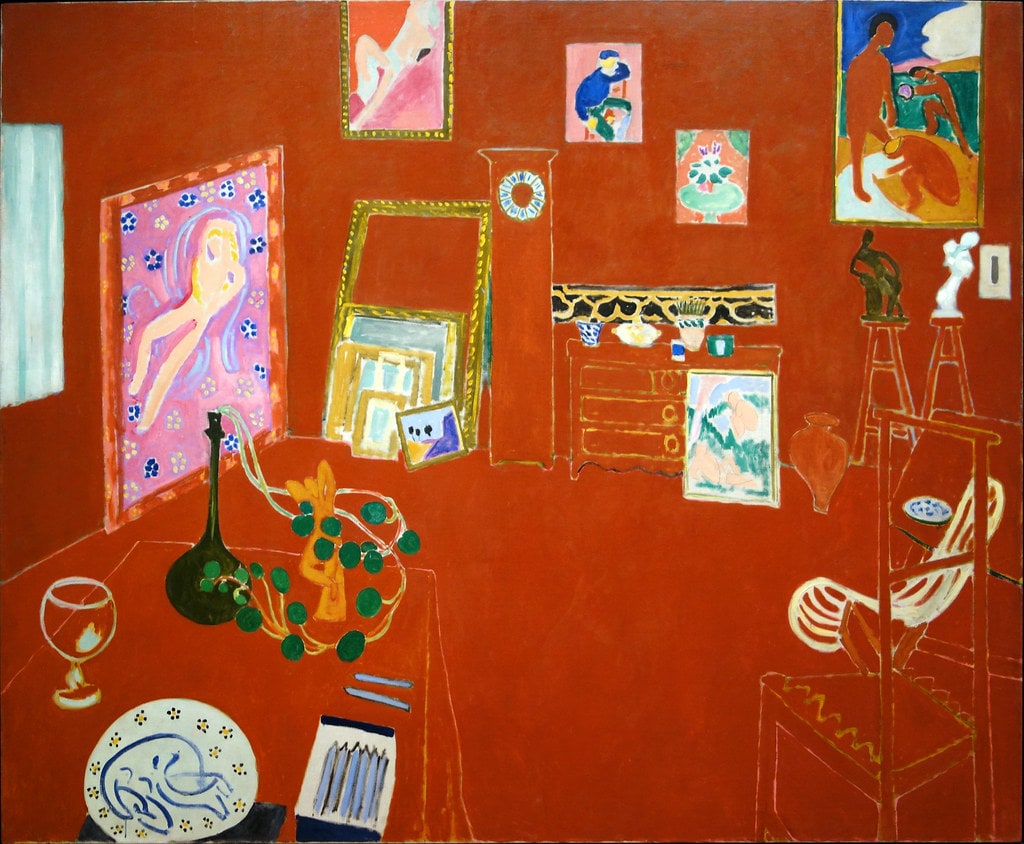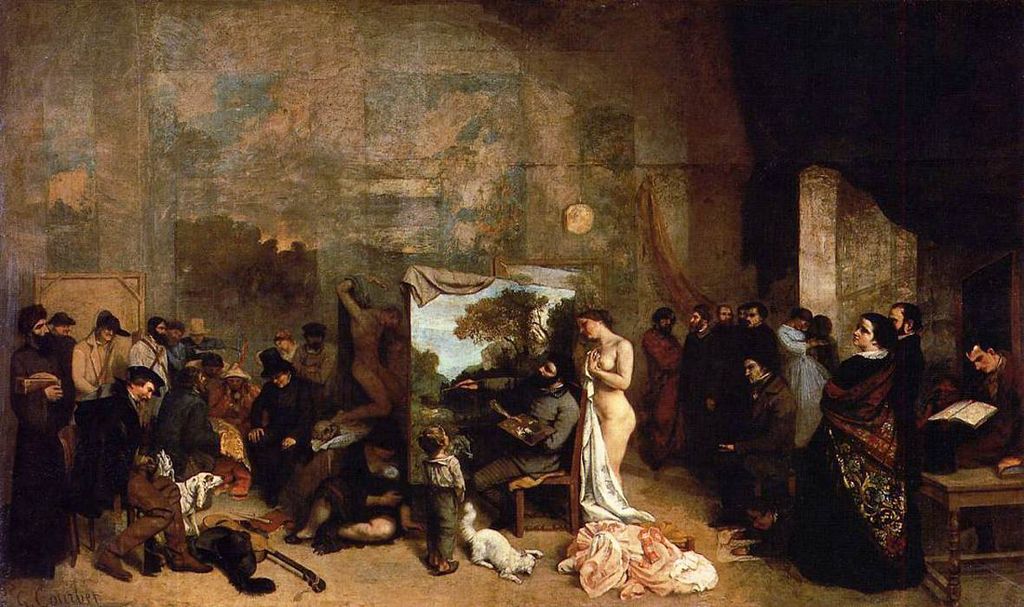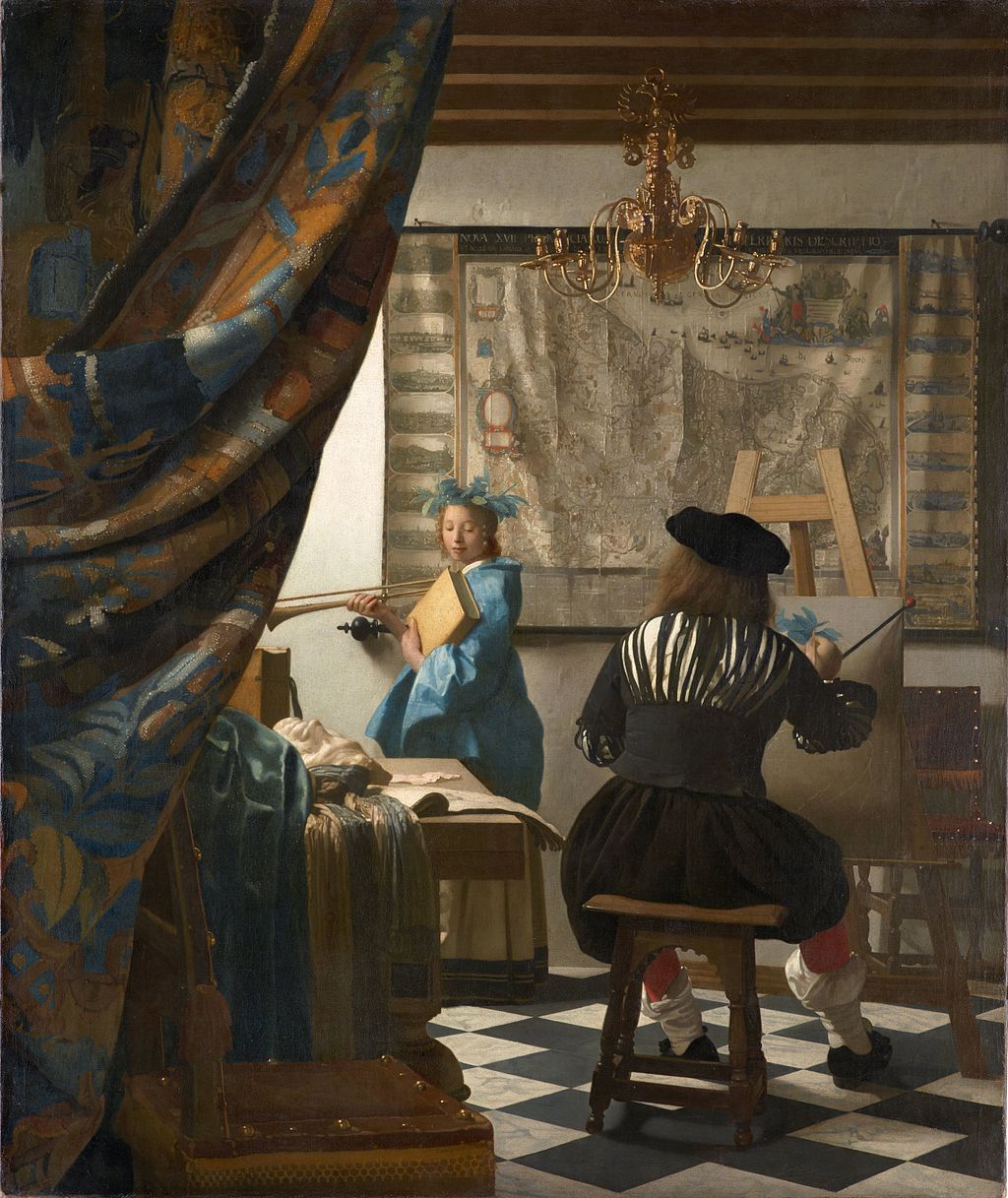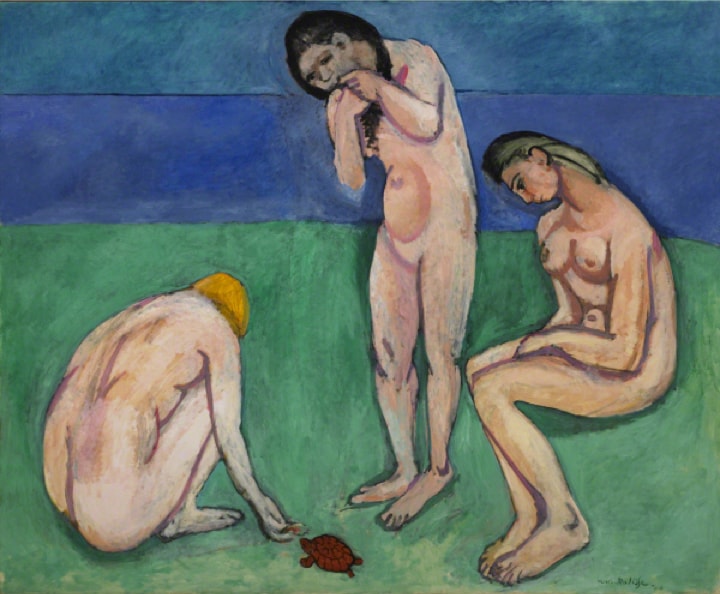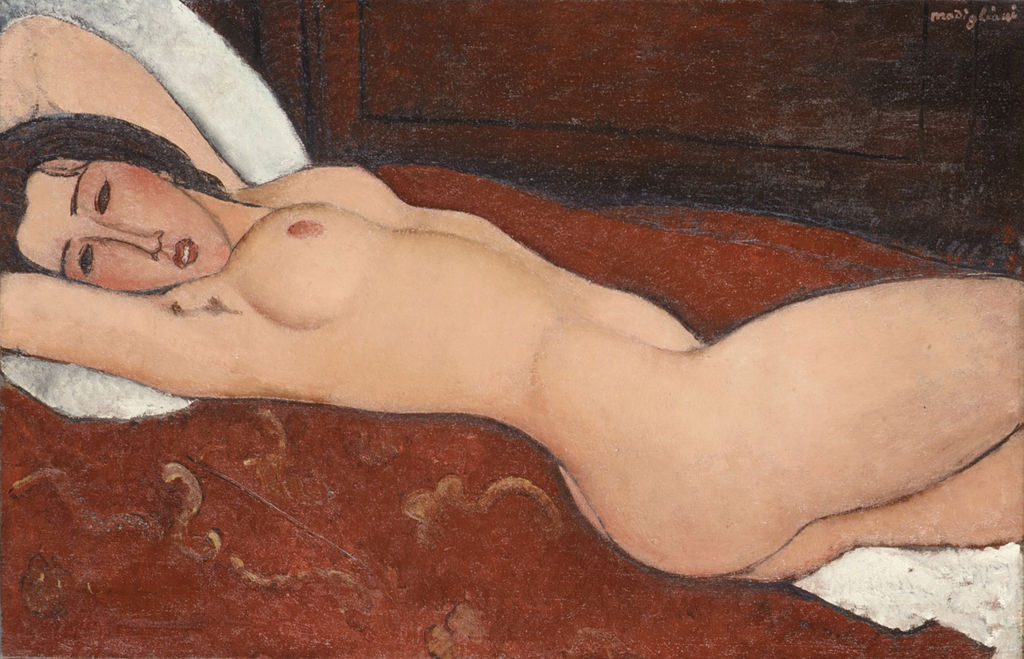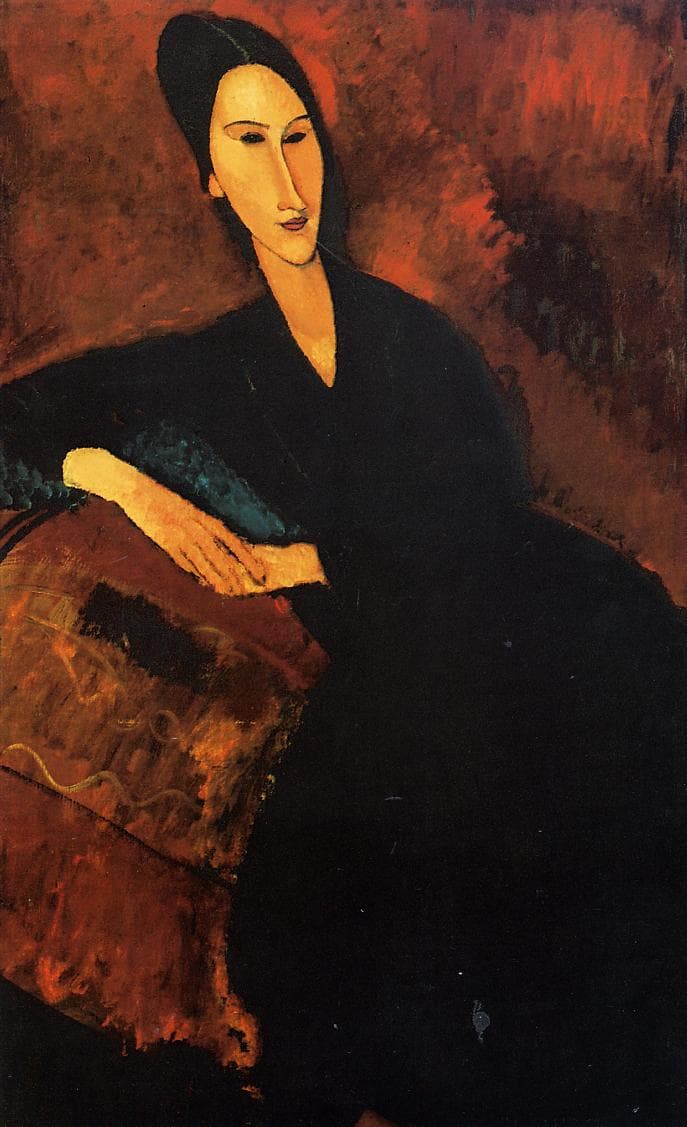|
Where? Room 506 on Floor 5 of the MoMA
When? 1911 What do you see? A look into the studio of Henri Matisse filled with his recent artworks scattered about the room. Among them are paintings on the walls, a stack of frames in the corner, vases, and ceramic plates. These objects seem randomly placed in the red room. Each painting, sculpture, and object is rendered in relative detail while the furniture in the room is represented with thin, almost invisible, yellow lines. Hardly present are a table, a dresser, two stools, a chair, and a grandfather clock with missing hands. This clock serves as the painting’s central axis and may suggest a disruption of time. Likewise, space is disrupted in the studio. The flatness of the red canvas is contrasted with a distorted perspective with improperly converging orthogonals and furniture that is depicted at varying angles. The curves of the plants on the table and the figures of his paintings contrasts with the rigidity of the picture frames, chairs, and the window on the far left. In this way, balance and harmony are created in the placement and color of the curated menagerie of objects in the studio. Backstory: The Red Studio, also known as L'Atelier Rouge, is part of a long-standing tradition of depicting the artist in his studio. Courbet, Velázquez, and Vermeer have all created similar paintings that show them at work in their own artistic space. But Matisse removes himself from his studio and instead represents himself with the artworks that are scattered around the room. These are all actual artworks that Matisse created. Matisse thus, untraditionally, represents himself with his own artworks. Matisse strays from tradition again by painting with reserve lines (rather than painting the entire canvas red and working on top of that layer, he leaves certain areas of the canvas unpainted and these unpainted areas form some of the lines and forms in this work). This can be seen in little gaps in paint near outlines where the bare canvas is revealed. This can be attributed to Matisse’s study of Cézanne’s works which is a departure from the Renaissance style of creating layers of oil paint.
Who is Henri Matisse? Henri Émile Benoît Matisse was born on December 31, 1869 in Le Cateau, France. When he was 22, he moved to Paris to study art. Already influenced by the Impressionists, he grew into a more abstract painter as he traveled the Mediterranean finding inspiration in the light there.
When Matisse returned from the Mediterranean, his work was exhibited alongside works by Derain and De Vlaminck, artists that were central in the formation of the Fauvist movement. While the other Fauvists received great criticism, Matisse’s reputation quickly grew. Finding identity in his Fauvist style, his works became more wild and colorful. In 1910, Matisse travelled to Spain and Morocco to study Islamic art and architecture. There, he found inspiration in patterns and incorporated detailed designs into his artworks. But just seven years later, Matisse retired to Nice and turned to a much more naturalistic style. Despite this regression, Matisse eventually returned to his abstract style in the 1930s only this time with paper cut-outs which include his Blue Nudes. Towards the end of his life, Matisse worked on the stained glass designs for the Chapel of the Rosary in Vence in the south of France. He died on November 3, 1954. Fun fact: The artworks in The Red Studio are all based on actual works by Matisse. These include Nude with a White Scarf (upper left) in the Statens Museum for Kunst in Copenhagen, Female Nude (lower right), and Bathers with a Turtle (upper right) in the St. Louis Art Museum.
0 Comments
Where? Room 12 of the San Diego Museum of Art
When? 1916 What do you see? A young boy dressed in a red t-shirt and jacket. The middle and inside of his jacket are white and black, but the red color dominates. He has parted his blond hair neatly and stares with his blue eyes at the viewer. But he does not seem to be comfortable. His rosy cheeks and unsettling gaze give the impression that the boy is shy and overwhelmed by the situation in front of him. Modigliani amplified these characteristics of the boy, just like he elongated his nose, neck, and head, and only gave him a small mouth. He used elegant lines for the outline of the boy, but also included asymmetry in many aspects, which is visible in the shape of the boy’s shoulders, face, ears, and hair. Backstory: The painting does not appear more than one hundred years old. The colorful outfit and timeless gaze make it look like this painting is much more recent. The painting is typical for Modigliani in that he simplified the subject in front of him and painted that with pleasant curves and lines on the canvas. The simple but pleasant style of Modigliani does not mean that the end result is always pleasant to look at. The blue-eyed boy, for example, does not look to be carefree and happy. Modigliani may have included some elements into this painting reflecting how he felt when he was a young boy as he had suffered from several serious diseases during his youth. Who is Modigliani? Amedeo Clemente Modigliani was born in 1884 in Livorno in the Northwest of Italy and died in 1920 in Paris. He was draughtsman, painter, and sculptor, but is best known for his paintings. He primarily created portraits and nudes, and these paintings are characterized by strongly elongated features. He painted several pictures of a reclining nude woman, one of which is in the Metropolitan Museum of Art. An example of his many portraits with elongated features is his portrait of Anna Zborowska in the Museum of Modern Art. Modigliani’s works were not positively received during his life but became very popular after his death. In 2015, one of his works – a reclining nude - sold for $170.4 million, making it to the top 10 of most expensive paintings ever sold.
Fun fact: The paintings of Modigliani are a popular target for art forgers. There are three reasons for this.
A striking example of how popular Modigliani’s work is among forgers was a 2017 exhibition of his works in Genoa, Italy. The exhibition was closed early because there was a suspicion that it may contain some forgeries. It turned out that 20 of the 30 works attributed to Modigliani were fake. |
Categories
All
|
- Home
- Blog
-
Museums
- Alte Pinakothek
- Art Institute of Chicago
- Baltimore Museum of Art
- Barber Institute of Fine Arts
- Bargello
- Barnes Foundation
- British Museum
- Church of Sant’Anastasia
- Cleveland Museum of Art
- Courtauld Institute of Art
- Detroit Institute of Arts
- Frans Hals Museum
- Galleria Borghese
- Gallerie dell'Accademia
- Getty Museum
- Guggenheim
- Hermitage Museum
- Kunsthistorisches Museum
- Kunstmuseum Basel
- Legion of Honor Museum
- Louvre
- Mauritshuis
- Metropolitan Museum of Art
- Musee d’Orsay
- Museum of Fine Arts in Boston
- Museum of Modern Art
- National Gallery in London
- National Gallery of Art
- National Museum in Poznań
- Norton Simon Museum
- Ny Carlsberg Glyptotek
- Palace of Versailles
- Palazzo Pitti
- Palazzo Vecchio
- Petit Palais
- Philadelphia Museum of Art
- Prado
- Pushkin Museum
- Ravenna Art Museum
- Rijksmuseum
- San Diego Museum of Art
- Santa Maria delle Grazie
- St. Peter's Basilica
- Städel Museum
- Statens Museum for Kunst
- Tate Britain
- Tate Modern
- Timken Museum of Art
- Uffizi
- Vatican Museums
- Wallace Collection
-
Artists
- Altdorfer
- Anguissola
- Berlin Painter
- Bosch
- Botticelli
- Boucher
- Bronzino
- Bruegel the Elder
- Brunelleschi
- Cabanel
- Caillebotte
- Canova
- Caravaggio
- Carpeaux
- Cezanne
- Cimabue
- David
- Degas
- Delacroix
- De Maria
- Donatello
- El Greco
- Fontana
- Fra Angelico
- Fragonard
- Gauguin
- Gentileschi
- Gericault
- Gonzalez-Torres
- Goya
- Hals
- Hogarth
- Hokusai
- Ingres
- Leonardo da Vinci
- Lippi, Filippo
- Longhi, Barbara
- Lorrain
- Makovsky
- Manet
- Massys
- Matisse
- Merian
- Michelangelo
- Mochi
- Modigliani
- Monet
- Panini
- Parmigianino
- Perugino
- Picasso
- Pisanello
- Raphael
- Rembrandt
- Renoir
- Reynolds
- Rivera
- Rodin
- Rubens
- Scultori
- Seurat
- Steen
- Tintoretto
- Titian
- Toulouse-Lautrec
- Turner
- Uccello
- Van der Weyden
- Van Dyck
- Van Eyck
- Van Gogh
- Van Hemessen
- Vasari
- Velazquez
- Vermeer
- Veronese
- Vigée Le Brun
-
Locations
- Books
- About Us

